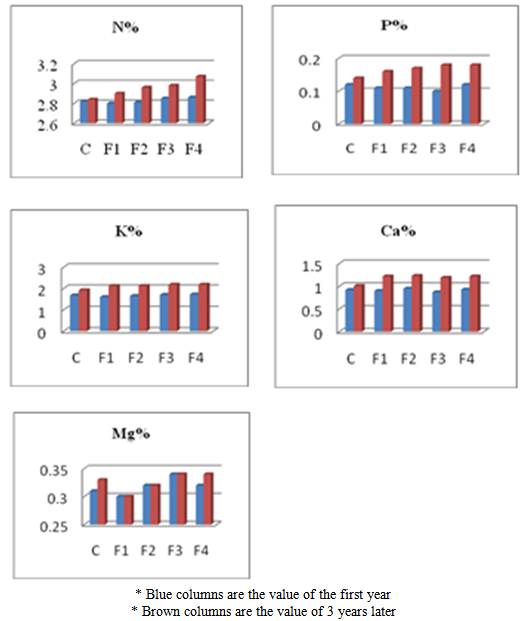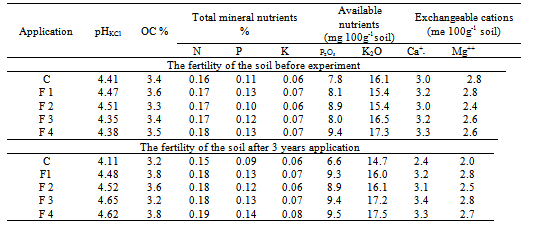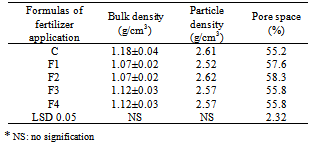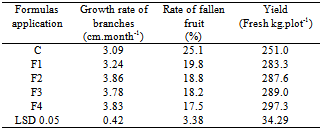-
Paper Information
- Next Paper
- Previous Paper
- Paper Submission
-
Journal Information
- About This Journal
- Editorial Board
- Current Issue
- Archive
- Author Guidelines
- Contact Us
Resources and Environment
p-ISSN: 2163-2618 e-ISSN: 2163-2634
2013; 3(4): 77-82
doi:10.5923/j.re.20130304.03
Evaluation of Coffee Husk Compost for Improving Soil Fertility and Sustainable Coffee Production in Rural Central Highland of Vietnam
Nguyen Anh Dzung1, Tran Trung Dzung2, Vo Thi Phuong Khanh3
1Institute of Biotechnology & Environment, Tay Nguyen University, 567-Le Duan, Buon Ma Thuot City, Viet Nam
2Department of Ecology and Environment, Faculty of Agriculture & Forestry, Tay Nguyen University, Vietnam
3Biology Department, Faculty of Natural Science & Technology, Tay Nguyen University, Vietnam
Correspondence to: Nguyen Anh Dzung, Institute of Biotechnology & Environment, Tay Nguyen University, 567-Le Duan, Buon Ma Thuot City, Viet Nam.
| Email: |  |
Copyright © 2012 Scientific & Academic Publishing. All Rights Reserved.
Coffee husk supplemented with cow manure, and fertilizers (phosphorus and urea) were studied. The results showed that 5.0% thermophosphate fertilizer, 1.0% urea fertilizer and 1.2m in height of heap were suitable conditions for composting coffee husk. The quality of the compost was better than original coffee husk and some bio-organic fertilizers on the agriculture market. The compost was used for coffee plant on the field with amount of 2.0-3.0 kg.plant-1.year-1 during 3 years and reduced using from 20% to 30% chemical fertilizers. The results showed that fertility of soil, mineral nutrients in the coffee leaf and the growth of the coffee were improved in comparison with plots that no using the compost.This report demonstrates a method of using agricultural waste-coffee husk to produce compost and contributes to inhibit environmental pollution in rural and develop eco-sustainable agriculture.
Keywords: Coffee Husk, Compost, Sustainable Farming
Cite this paper: Nguyen Anh Dzung, Tran Trung Dzung, Vo Thi Phuong Khanh, Evaluation of Coffee Husk Compost for Improving Soil Fertility and Sustainable Coffee Production in Rural Central Highland of Vietnam, Resources and Environment, Vol. 3 No. 4, 2013, pp. 77-82. doi: 10.5923/j.re.20130304.03.
Article Outline
1. Introduction
- Vietnam is one of the biggest coffee exporters in the world with an estimated annual production of one million tons, of which Central Highland contributes up to 90 percent of the total coffee production. Central Highland consists of five provinces: Dak Lak, Dak Nong, Gia Lai, Kon Tum and Lam Dong. These covers an area of 500,000 ha of coffee (Coffea canephora var Robusta) farm with a production of 800,000 to 900,000 tons coffee bean. Therefore, coffee husk waste released annually from coffee production in Central Highland ranges from 400,000 to 500,000 tons. Generally, there are two methods for processing coffee cherries being dry and wet methods. These release solid waste such as coffee husk and coffee pulp. In Vietnam, over 90% of coffee cherries are processed by dry method. Pandey et al.[1]; Bressani and Braham[2] showed that coffee husk is rich in organic matter (cellulose, hemicelluloses, pectin and lignin), and chemical nutrients such as nitrogen (N) and potassium (K). Additionally, coffee husk also containssecondary compounds such as caffeine, tannin and polyphenol. Therefore, coffee husk and coffee pulp have great potential for biotechnology.Due to the high content of caffein and tannin, coffee pulp was fermented for animal feed. Composition of coffee pulp determined by Bressani and Braham[2] showed that it contains carbohydrate (63.2%), total protein (10.1%),reduced sugar (12.4%), ash (8.3%), and caffein (1.3%). After fermentation process, caffein and tannin contents are reduced in coffee pulp and used for animal feed[2-4]. Coffee husk and coffee pulp have been used as a suitable substrate for mushroom cultivation such as Pleurotus sp., Pleurotus ostreatus[5].Coffee husk contains some amount of caffeine and tannins, which can make it toxic and slow degradation in nature, resulting the disposal problem. However, coffee husk is rich in lignocelluloses materials, which makes it an ideal substrate for microbial processes. Several solutions and alternative uses of coffee husk/pulp have been attempted. Coffee husk and coffee pulp have been used as a raw material for bioprocess to produce biogas, enzymes, mushroom and compost[6],[1],[7]. Coffee husk and coffee pulp have been usually incubated for composting as the recycling of organic wastes in agriculture. Composting of coffee husk was also reported by Biddapa et al.[8]. Mixture of coffee husk, animal manures and phosphate rock was fermented by two anaerobic and aerobic methods. The compost can be used for soil application after 6 months of composting. The quality of the compost was improved in comparision with before that. Coffee fruit peel was mixtured with swine waste, bovine manure and other agricultural wastes and incubated for compost. The nutrients in the leaf and resistance of rust disease of coffee increased by the compost application has been discussed by Santos et al.[9]. Composting mixture prepared by mixing coffee husk, sawdust, biochar and poultry manure with various rate were reported by Dias et al.[7]. After 210 days of composting process, organic matter loss was from 67% to 78% compared with initial content. Generally, composting of coffee husk and other agricultural wastes reduce the consumption of natural resources and recycle nutrients, increase in soil organic matter and impove the physical, chemical and biological characteristics of soil[10]. Additionally, untreated coffee husk has been used as potetial biosorbents for treatment of dye contaminated waters and heavy metals[11],[12]. Coffee ground is one of the wastes has been studied to recycle by composting andvermicomposting[13].In Vietnam, coffee husk is normally burnt or covered on the coffee field, so, untreated coffee husk will spread diseases and pets to next crop. Some farmers mix up coffee husk with manure, but this way shows less efficiency. Generally, Coffee farmers have used mainly chemical fertilizers and lack of organic fertilizer for long time, therefore, the soil has been degrading. Whereas, about 500,000 tons of coffee husk, a good organic material has not been used or used not efficiently. Coffee husk was also used as compost supplemented with 5% of lime, and 10% phosphorus fertilizer, but not used microbial seed, resulted in long time of composting process, slow degradation of organic matter.[14]. Generally, coffee husk and coffee pulp has been applied by mixturing with animal manures, other agricultural wastes used as compost and the incubation period of composting has been taken for long time, because most researches have used natural micro-organisms for composting, which are noteffective.The aim of this research was to evaluate the effects of coffee husk compost on soil fertility, uptake of nutrients in the leaves, growth and yield of coffee plants. This is to ensure sustainability of coffee production and reduceenvironmental pollution resulting from coffee processing in the generation,
2. Materials and Methods
2.1. Materials
- Microactive seed for compost was obtained fromBiotechnology Center, Tay Nguyen University, Vietnam. Contents: Trichoderma sp., Streptomyces sp. with 109CFU.g-1. Cow manure was collected from cow farms in Ea Kar District and cows from this farm only feed on natural grasses. Urea (46% total N) was a product of Phu My company, Vietnam and thermophosphate (16% available phosphorus) was a product of Van Dien thermophosphate fertilizer factory, Vietnam.
2.2. Methods
- Coffee husk compostCoffee husk (875 kgs) was mixed with 10% cow manure (w/w), supplemented 2% lime (w/w), 0.5% urea (w/w) and water to reached 60% humidity of the mixture. One kilogram of effective microorganisms containing Trichoderma sp. and Streptomyces sp. being suspended in 50 liters of fresh water and sprayed for 1000kgs of the mixture. The mixture was heaped up with 120cm in height and covered with agriculture wastes such as leaves, rice paddy and incubated for 90 days. The mixture was composted for 3 months, and then supplemented with 0.1% (w/w) effective microorganisms consisting nitrogen fixing Azotobacter sp. and soluble phosphate bacteria Bacillus megaterium. The application of compost was carried out on the coffee field in Coffee Company No. 721 for years. Coffee plants (Coffea canephora var robusta) have been planted on ferralsols since 1990. The experiment had 5 formulas and triplicates (total 15 plots; 25 coffee plants for each plot) with the same cultivation technique and different fertilizer application:− Control (C): 100% chemical fertilizer application was same technical process of the coffee company (N: P2O5 : K2O: 220-80-240).− Formula 1 (F1): 70% chemical fertilizer of the control and 3 kg of the compost.− Formula 2 (F2): 80% chemical fertilizer of the control and 2 kg of the compost.− Formula 3 (F3): as the control and addition of 2 kg of the compost.− Formula 4 (F4): as control and addition of 3 kg of the compost.Chemical fertilizers were applied in three phases: early, mid and the end rainy season and all of the compost was applied with the first application of chemical fertilizer in early rainy season.
2.2. Sampling Methods
- The compost and soil samples were collected from 5 different places each plot and mixed up one sample. Growth of branches and mature fruit ratio of coffee was measured 5 branches each plant and 5 plants each plot. The leaf samples were collected from 5 plants each plot and 5 leaves each plant in the morning after 2 months fertilizer application.
2.3. Analytical Methods
- The temperature of the compost heap was measured by thermometer at 9:0 a.m. every day. The pH of the compost was measured on a 1: 10 (w/v) water suspension of the composting samples. The organic matter (OM) content was determined by loss on ignition of the dry mass at 550℃. Organic content (OC) of the samples was determined by Walkley-Black method[15] and total nitrogen was determined by Kjeldahl method. Total phosphorus was digested by fluoro boric acid procedure[16] and available phosphorus were measured by the colorimetric molybdate blue method[17]. Total and available potassium was measured by flame spectrophotometer. Total calcium and total magnesium were measured by titration with Trilon B. Exchangeable Ca2+ and Mg2+ were extracted from soil by ammonium acetate method (Thomas, 1982)[18] andmeasured by titration with Trilon B .Bulk density of the soil is weight of 1 cm3 disturbed soil calculated by equation:D = P/VWhere D is bulk density (g/cm3); P is dried weight of the soil; V is volume of the soil (cm3).[19]Particle density of the soil was determined by using a graduated cylinder and determination of pore spaces by Tan et al. 1990 method.[19]
2.4. Statistical Analysis
- Differences in means between treatments were tested by one-way ANOVA, and multiple factors by 2-way ANOVA with subsequent post comparisons of mean (LSD test, at P=0.05).
3. Results and Discussions
3.1. Composting Process Performance
- Before research of composting process, coffee husk for composting was analyzed (Table 1).
|
|
3.2. Effect of the Compost Application on Fertility of the Soil
- The compost was applied for coffee plants. 2kgs to 3kgs of the compost were used to substitute partially chemical fertilizer with purpose being to reduce using chemical fertilizers, improve the fertility of the soil and protect soil environment from erosion and degradation. The first year of application, the fertility of soil was not improved in comparison with control (using 100% chemical fertilizer), because the compost was organic fertilizer, so it was slow effectiveness on the fertility of soil and plants shown in Table 2.The fertility of the soil in the control expresseddegradation such as: pH decreased from 4.41 down to 4.11; OC% from 3.41 down to 3.28; available and total nutrients as nitrogen, phosphorus and potassium also reduced clearly. It indicated that if cultivation of coffee only used chemical fertilizers leaded to degradation of the soil and coffee production became unsustainable. In formulas that applying from 2kgs to 3kgs of the compost improved the fertility of the soil. pH of the soil increased from 4.11 to 4.52 in plots that applied 2kgs to 3kgs of the compost after three years of the treatment. Particularly, OC% and N% and total phosphorus enhanced significantly in comparison with the control. For examples: OC% enhanced from 3.28% in control (C) up to 3.82% (F2); total N% from 0.154% (C) up to 0.18% (F2). Available nutrients and cationic exchange also improved clearly compared with the control.In addition, physical structure of the soil such as bulk density, particle density and pore space also trend toimprovement better than the control. Particularly, pore space of the soil increased from 55.2% (control) up to 58.3% (F2). Improvement of pore space makes plants adsorption of the nutrients better and effective microorganisms growth stronger. It is lead to reduce using chemical fertilizer and maintain the fertility of the soil (Table 3).After three years of the compost application on the coffee field, the results shown in Table 2 concluded that applying only chemical fertilizers in cultivation of coffee leaded to reducing in pH, OC %, total N%, P%, K% and available nutrients and increasing in degradation of the soil. Our results were as same as report of Santos et al.[9] on composting coffee fruit peel with swine waste and some other waste. After two years applying the compost for coffee plant, fertility of the coffee soil as OM%, total N%, P%, K% was improved in comparison with control test.
|
3.3. Effect of the Compost Application on Uptake of Mineral nutrients in the Coffee Leaves
- The content of mineral nutrients in the soil has close interrelation with uptake of mineral nutrients in the leaves. After 2 months of fertilizer application, the coffee leaves were collected and analyzed. Results shown in Fig 1 indicated that a partial substitution of compost application had not been effective on uptake of nutrients in the leaves before experiment. This expressed in Table 3 that the fertility of the soil unchanged between formulas of application. It had even reduced slightly in F2 and F3 in comparison with the control (application of 100% chemical fertilizer). It was explained that chemical fertilizer was easy for uptake, but using the compost needed long time to degrade andmineralize and express effectiveness. Westerman and Bicudo also showed that increasing in using organic fertilizer contributed to improve the physical, chemical and biologicalcharacteristics of soil and sustainable agricultural cultivation[10]. In addition, activity of effective microorganisms in the compost such as nitrogen fixing bacteria and phosphate soluble bacteria also play important roles to increase in uptake mineral nutrients in the leaves of the coffee. Morikawa and Saigusa also showed that application of coffee ground compost increased available Fe for plants[22].It was clear that content of mineral nutrients in the leaves were improved significantly in formulas which substituted partially with the compost. The content of N%, P% and K% in the formula 1 and formula 2 increased higher by 4.2%, 14% and 10% than control. For examples: 2.84% N; 0.14% P; 1.92% K in the control increased up to 2.96% N; 0.17%P and 2.12%K in the F2. The content of mineral nutrients in the control had a trend of slight deficiency, but it was suitable for the growth and development of coffee in F2, F3 and F4. The balanced nutrients in the leaves of coffee was very important for growth and sustainable yield[23].
 | Figure 1. Effect of the compost application on mineral nutrients of coffee leaves |
3.4. Effect of the Compost Application on the Growth and Yield of Coffee on the Field
- Growth of coffee branches effects strongly on the yield of next crop. Supplementation of the compost which had rich organic fertilizer for coffee increased in growth rate of coffee branches such as Table 4. Improvement of the soil fertility (shown in Table 2, Table 3) and nutrient uptake in the leaves (shown in Fig 1) leaded to increase in the growth of coffee branches and crop yield (Table 4).
|
4. Conclusions
- Coffee husk, a rich organic agricultural waste andpotassium was good material for composting process. To reduce the time of composting and improve the quality of the compost should supplement 1% urea, 5% thermo phosphate fertilizer, 10-20% animal manure and 0.1% effective microorganisms. After three months of incubation by heap method, the compost was ready for using and reduced 60% time of the process compared to Dias’s protocol[7]. Partial substitution of chemical fertilizer with the compost contributed to improve the fertility of the coffee soil, nutrient uptake in the leaves, the rate of branch growth and increase up to 14% yield in comparison with control and Santos’s work[9]. Additional, using the compost also contributed to inhibit environmental pollution in rural and develop eco-sustainable agriculture.
ACKNOWLEDGEMENTS
- The authors acknowledge financial supports fromDepartment of Science and Technology, Dak Lak province and Swiss - Vietnam Research Cooperation Program SIDA - SAREC.
 Abstract
Abstract Reference
Reference Full-Text PDF
Full-Text PDF Full-text HTML
Full-text HTML


